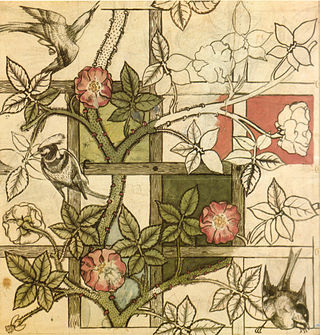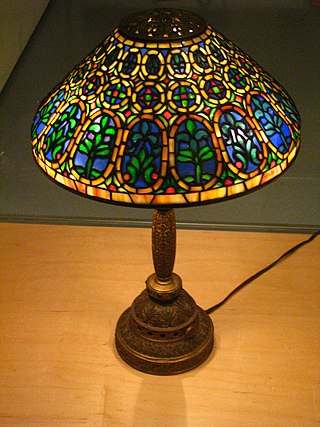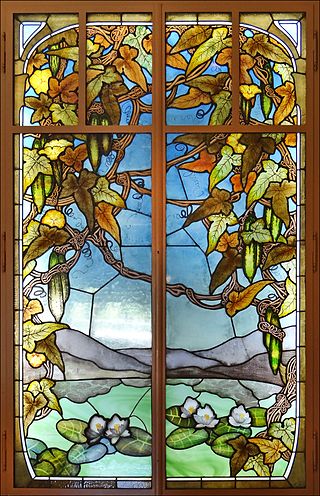
The Arts and Crafts movement was an international trend in the decorative and fine arts that developed earliest and most fully in the British Isles and subsequently spread across the British Empire and to the rest of Europe and America.

Gustav Stickley was an American furniture manufacturer, design leader, publisher, and a leading voice in the American Arts and Crafts movement. Stickley's design philosophy was a major influence on American Craftsman architecture.

A Tiffany lamp is a type of lamp made of glass and shade designed by Louis Comfort Tiffany or artisans, mostly women, and made in his design studio. The glass in the lampshades is put together with the copper-foil technique instead of leaded, the classic technique for stained-glass windows. Tiffany lamps are considered part of the Art Nouveau movement. Considerable numbers of designs were produced from 1893 onwards.

Albert Louis Gilles was a French coppersmith known for his metalwork technique of shaping malleable metals. During his career as an artisan and designer, Gilles created public and private works for The Walt Disney Company, Chrysler, and General Motors. He is known for his later works depicting the life of Jesus Christ.
Karl Emanuel Martin "Kem" Weber (1889–1963) was an American furniture and industrial designer, architect, art director, and teacher who created several iconic designs of the Streamline style.
The Bay Area Figurative Movement was a mid-20th-century art movement made up of a group of artists in the San Francisco Bay Area who abandoned working in the prevailing style of Abstract Expressionism in favor of a return to figuration in painting during the 1950s and onward into the 1960s.

Kataro Shirayamadani, also known as Kitaro Shirayamadani, was a Japanese decorative ceramics painter who worked for Rookwood Pottery in Cincinnati, Ohio from 1887 until 1948.
Los Angeles Modern Auctions (LAMA) is the first auction house to specialize in 20th century Modern art and design. Founded by Peter Loughrey in 1992, LAMA especially champions Modern and Contemporary works by California and West Coast artists and designers.
Lawrence Buck (1865—1929) was an American architect, artist and landscape painter, associated with the Prairie School and the American Arts and Crafts Movement.

École de Nancy, or the Nancy School, was a group of Art Nouveau artisans and designers working in Nancy, France between 1890 and 1914. Major figures included the furniture designer Louis Majorelle, ebonist and glass artist Jacques Grüber, the glass and furniture designer Émile Gallé, and the crystal manufactory of Daum. Their work was largely inspired by floral and vegetal forms found in the region. The goal of the group was to produce in series ordinary objects, such as furniture, glassware, and pottery, with fine craftsmanship and in original forms, making art objects available for people's homes.
Gary Lee Noffke is an American artist and metalsmith. Known for versatility and originality, he is a blacksmith, coppersmith, silversmith, goldsmith, and toolmaker. He has produced gold and silver hollowware, cutlery, jewelry, and forged steelware. Noffke is noted for his technical versatility, his pioneering research into hot forging, the introduction of new alloys, and his ability to both build on and challenge traditional techniques. He has been called the metalsmith's metalsmith, a pacesetter, and a maverick. He is also an educator who has mentored an entire generation of metalsmiths. He has received numerous awards and honors. He has exhibited internationally, and his work is represented in collections around the world.

The Memphis Group, also known as Memphis Milano, was an Italian design and architecture group founded by Ettore Sottsass. It was active from 1980 to 1987. The group designed postmodern furniture, lighting, fabrics, carpets, ceramics, glass and metal objects.
Klaus Rudolf Werhand was a metalsmith and a coppersmith from Neuwied, Rhineland-Palatinate, Germany.

Harrison Edward McIntosh was an American ceramic artist. He was an exponent of the Mid-century Modern style of ceramics, featuring simple symmetrical forms. His work has been exhibited in venues in the United States including the Smithsonian and internationally including at the Louvre in France.

Lillian McNeill Palmer (1871-1961) was an American coppersmith and metalsmith whose work was part of the California Arts and Crafts movement. She worked in tandem with her longtime companion, architect Emily Williams and was the founder of the Women's Business and Professional Club in San Francisco.

Elizabeth Eleanor D'Arcy Gaw was a prominent Arts and Crafts artist whose style influenced her former business partner Dirk van Erp and noted architect Lawrence Buck. She was the president of the California Guild of Arts and Crafts.

Rick Dillingham (1952–1994) was an American ceramic artist, scholar, collector and museum professional best known for his broken pot technique and scholarly publications on Pueblo pottery.
Lucia Mathews was an American painter born and raised in San Francisco, California, primarily known for her work depicting California landscapes and the state flower, the California Poppy. A lifelong Californian, she was the wife and partner of artist, Arthur Frank Mathews, a well-regarded painter, muralist, and teacher in the Bay Area. Together they founded the Furniture Shop and the Philopolis Press in 1906. Her work is featured in museum collections throughout California and the United States and is evocative of the California Arts and Crafts style.

William Morris (1834-1898), a founder of the British Arts and Crafts movement, sought to restore the prestige and methods of hand-made crafts, including textiles, in opposition to the 19th century tendency toward factory-produced textiles. With this goal in mind, he created his own workshop and designed dozens of patterns for hand-produced woven and printed cloth, upholstery, and other textiles.

The Khalili Imperial Garniture is a trio of cloisonné vases created for a Japanese Imperial commission during the Meiji era. The items were exhibited at the World's Columbian Exposition in Chicago, United States, in 1893, where they were described as "the largest examples of cloisonné enamel ever made". The decoration of the vases represents virtues and the seasons, and also has an allegorical meaning about Japan's role in a changing world and its alliance with the United States. After being exhibited, the vases were separated from each other for more than 120 years, eventually reunited in 2019 in the Khalili Collection of Japanese Art, a private collection assembled by the British-Iranian collector and scholar Nasser D. Khalili.
















